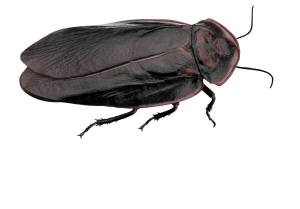 Since moving to Florida as a Yankee, I’ve learned most things about native pests the hard way.
Since moving to Florida as a Yankee, I’ve learned most things about native pests the hard way.
Mutant-size Roaches
While unpacking that first week, I learned the two-part horror of what the gentry euphemistically calls a Palmetto bug. The first horror is that it looks like a mutant-size roach, so when one skittered along the floorboard, I mistook it for a mouse. Then it ran up the wall. After I crept up to it, with my arm drawn back, shoe in hand, the second horror manifested itself. The mutants fly! It flew at my face and landed in my hair. For a few minutes, I flailed on the carpet, smacking my head with the shoe and screaming with my mouth shut. (My brothers witnessed it, so yeah, they will gleefully describe it to others at any opportunity.) Welcome to Florida.
Fire Ants
Within the month, I learned the Fire Ant Dance. All the craze in this giant sandlot state, the dance begins by standing in one place on a green lawn. You will feel nothing as a legion of tiny red ants sneaks up your legs. The ants attack with the kind of silent, uniform precision that Navy Seals employ. The dance grows frantic in a combination of primal scream therapy and hopping, gyrating, and jerking movements that were popular in the sixties. But the dance doesn’t end when you’ve smashed the last hateful ankle-biter. No, then the itching pustules form to haunt you for days, lingering as tiny souvenirs of this nature encounter. I long considered bug repellent my signature scent.
Termites
The most expensive lessons on native insects came after we bought our first home. A Mediterranean-style beauty, our first home consumed a decade of savings in the down payment. We were so proud to live in it. So, apparently, were the termites. The Subterraneans introduced themselves by burrowing up through a microscopic crack in the foundation, up the furring, to poke their tiny pinchers through a pin-point hole in the drywall. A small pile of sawdust was the first clue of their presence. Evicting them meant boring holes in the foundation inside and outside into the porch and the pool deck.
But then their cousins, the drywoods, awoke from their mystic slumber in the lumber and chewed their way down through a door jamb. We temporarily moved out while the exterminators filled our home with noxious fumes. Our cherished dwelling looked like a circus tent for days. The neighborhood kids gathered to ask if there would be elephants and cotton candy. Again, let me remind the gentle reader that Florida is a giant sandlot, the perfect breeding ground for armies of vicious, well-organized pests.
Mosquitos
Without porch screens, Florida would be entirely uninhabitable. The mosquito, the state bird, comes in three distinct varieties—the blind, the biting, and the oh-dear-Lord size. The blind mosquitoes swarm like gnats, rising in clouds off the lawn in their peculiar three-day life cycle, then they die off, leaving what looks like black snowdrifts at doorways. The biters, well, the males buzz and don’t bite. The silent females are so aggressive that they will suck blood through leather shoes. The third kind of mosquito might not be a mosquito at all, but it looks like one, only much, much larger. I’ve heard rumors that the State of Florida breeds these giants because they eat the larvae of the biters. The state-sponsored giants look like they can cart off half a pint of blood each, but they are the good guys. Nonetheless, it has taken years to overcome the instinct to swat them.
Spiders
Spiders bother me the most. Florida is home to the Brown Recluse, the Black Widow, the Banana, and many other alarming varieties of toxic web spinners. Sure, they help reduce the mosquito population, but when my shrubs get covered in webs every fall, gardening is over until January. I’ve learned to watch for the distinctive zigzag pattern of the Banana Spider’s web. Once, I sprayed hornet spray directly on a Banana Spider, saturating him and knocking him off his web. He was back the next day. Chemical warfare was not enough. It took a shovel to prevent him from breeding.
Forget the cute fuzzy caterpillars of children’s books. Florida has poisonous caterpillars wearing Halloween colors. I suppose they become that way because they exfoliate Oleanders, you know, the tourist-killing plants whose straight toxic branches look perfect for roasting marshmallows. These caterpillars transform into red-bellied black moths, not butterflies. It figures.
After twenty winters in Wisconsin and Indiana, I’m in Florida to stay despite the insects, the hurricanes, the alligators, and the snakes. I had considered drafting a brochure to warn newcomers about the pests here, but then my neighbor explained that the difference between a Yankee and a Damn Yankee is whether they visit or move here, so that brochure idea quietly vanished. So, welcome to Florida, where it is considered sacrilege to point out that the center of tourism is a rodent theme park. Pests? What pests? This is America’s playground, and I’m thrilled to live here.
__________
Tampa Bay Sounding, a publication within the high-IQ organization Mensa.
